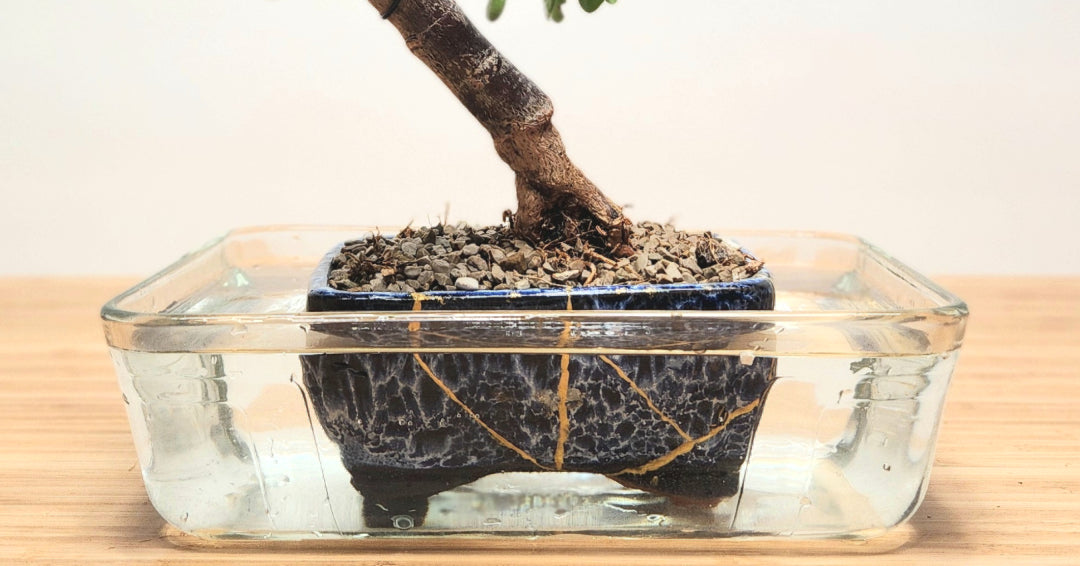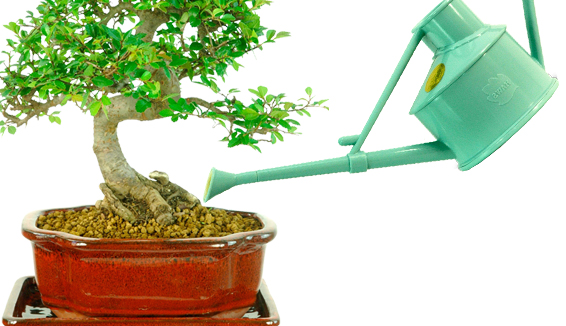Water a bonsai tree two to three times a week, depending on its species and environmental conditions. Bonsai trees are miniature versions of full-grown trees, requiring meticulous care.
Proper watering is essential for their health and growth. Overwatering or underwatering can harm the tree. Check the soil moisture regularly to ensure it stays slightly damp. Different species have varying water needs, so research your specific bonsai type. Indoor bonsai may need more frequent watering than outdoor ones due to less exposure to natural rain.
Use a watering can with a fine nozzle to avoid soil erosion. Consistent care and observation will help your bonsai thrive, reflecting your dedication to this unique horticultural art form.

Credit: bonsaibar.com
Introduction To Bonsai Care
Bonsai trees are small, beautiful, and need special care. Learning how to care for a Bonsai tree is crucial for its health. One of the most important aspects of Bonsai care is watering.
Importance Of Proper Watering
Proper watering is key to keeping your Bonsai tree healthy. If you water too little, the tree will dry out and die. Too much water can cause root rot, which is deadly for the tree.
Below are some reasons why proper watering is important:
- Prevents Drying Out: Ensures the tree gets enough moisture.
- Prevents Root Rot: Avoids excess water that can damage roots.
- Promotes Growth: Aids in the tree’s overall development.
Common Myths
There are many myths about watering Bonsai trees. These can confuse new Bonsai owners.
Here are some common myths:
- Myth: You should water Bonsai trees every day.
Truth: Bonsai trees need water based on their soil and environment. - Myth: Bonsai trees need less water in winter.
Truth: They may need the same amount or more, depending on indoor conditions. - Myth: You can water Bonsai trees on a set schedule.
Truth: Watering needs can change daily based on weather and soil.
Understanding these myths helps you care for your Bonsai better.
Factors Affecting Watering Frequency
Understanding how often to water a bonsai tree is crucial. Several factors influence watering frequency. These include the type of bonsai tree, the climate, and the season.
Type Of Bonsai Tree
Different bonsai trees require different watering schedules. Some trees like the Juniper Bonsai need less water. Others like the Ficus Bonsai need more frequent watering.
Here’s a table that shows the watering needs of common bonsai trees:
| Bonsai Tree Type | Watering Frequency |
|---|---|
| Juniper Bonsai | Every 2-3 days |
| Ficus Bonsai | Every day |
| Maple Bonsai | Every 1-2 days |
Climate And Season
The climate and season also play a big role. In summer, the soil dries out faster. You may need to water your bonsai daily.
During winter, the tree is dormant. Water less often, perhaps once a week.
Here are some tips for different seasons:
- Spring: Water every 2 days.
- Summer: Water every day.
- Autumn: Water every 2-3 days.
- Winter: Water once a week.
Identifying Water Needs
Knowing how often to water your bonsai tree is crucial. This depends on understanding its water needs. Correct watering keeps your bonsai healthy and thriving. Let’s explore how to identify these needs.
Soil Moisture Levels
The soil moisture level is key to your bonsai’s health. Check the soil daily with your finger. Insert it about an inch deep. If the soil feels dry, it’s time to water. If it feels damp, wait a day before checking again.
Use a moisture meter for more accuracy. This tool helps you avoid overwatering or underwatering. A table can help you understand the moisture level readings:
| Moisture Level | Action |
|---|---|
| Dry | Water immediately |
| Damp | Check again tomorrow |
| Wet | Do not water |
Signs Of Overwatering And Underwatering
Overwatering and underwatering have clear signs. Knowing these signs helps you adjust your watering routine.
Signs of Overwatering:
- Yellowing leaves
- Mushy roots
- Mold on the soil surface
Signs of Underwatering:
- Dry, brittle leaves
- Soil pulling away from the pot
- Drooping branches
Watch for these signs to keep your bonsai in perfect health. Adjust your watering based on these observations.
Best Time To Water
Watering your bonsai tree at the right time is crucial. The timing affects the tree’s health and growth. Let’s explore the best times to water.
Morning Vs. Evening
Morning is an excellent time to water your bonsai tree. The water has all day to soak into the soil. This helps prevent root rot. The tree also gets refreshed and ready for photosynthesis.
Watering in the evening has its pros too. The water won’t evaporate quickly. This ensures the tree stays hydrated overnight. But be cautious. Wet leaves overnight can lead to fungus.
Seasonal Adjustments
The season affects how often you should water your bonsai. During spring and summer, the tree needs more water. Higher temperatures mean faster evaporation. Check the soil daily during these months.
In fall and winter, the tree needs less water. Cooler temperatures slow down evaporation. Watering once or twice a week might be enough. Always check the soil moisture first.
| Season | Watering Frequency |
|---|---|
| Spring | Daily |
| Summer | Daily |
| Fall | 1-2 times a week |
| Winter | 1-2 times a week |
By understanding the best time to water, you help your bonsai thrive. Adjust your routine based on the season and time of day.
Watering Techniques
Proper watering techniques are essential for the health of your bonsai tree. Understanding the right methods can help you keep your bonsai thriving. Here, we explore two primary techniques: top watering and bottom watering.
Top Watering
Top watering is the most common method for watering bonsai trees. It involves pouring water directly onto the soil surface.
To do this effectively:
- Use a watering can with a fine nozzle.
- Pour water slowly to avoid disturbing the soil.
- Continue until water drains from the bottom holes.
Top watering ensures the entire root system gets water. It also helps to wash away any salt buildup on the soil surface.
Bottom Watering
Bottom watering involves placing the bonsai pot in a shallow container filled with water. The soil absorbs water through the drainage holes.
Steps for bottom watering:
- Fill a shallow container with water.
- Place the bonsai pot in the container.
- Leave it for 10-15 minutes.
- Remove the pot once the soil surface feels moist.
Bottom watering is great for ensuring deep root hydration. It also reduces the risk of washing away soil nutrients.
Both top and bottom watering techniques have their benefits. Understanding these methods can help you decide the best way to water your bonsai tree. Regular watering keeps your bonsai healthy and vibrant.

Credit: www.bonsaidirect.co.uk
Tools And Equipment
Taking care of a bonsai tree requires the right tools and equipment. Proper watering is crucial to keep your bonsai healthy. Below are some essential tools to help with watering.
Watering Cans
A good watering can is essential for bonsai care. Choose one with a fine spout. This allows water to flow gently and evenly. Avoid splashing soil or damaging roots. Here are some features to look for in a watering can:
- Fine spout for gentle watering
- Lightweight material for easy handling
- Long spout to reach all parts of the bonsai
Using a proper watering can helps maintain soil structure. It also prevents over-watering.
Moisture Meters
A moisture meter can be a lifesaver for bonsai owners. It helps you know the exact moisture level in the soil. This tool ensures your bonsai gets the right amount of water. Here are the advantages of using a moisture meter:
- Prevents over-watering and root rot
- Ensures the soil is consistently moist
- Easy to use and read
Insert the probe into the soil to get an instant reading. This makes it easier to water your bonsai correctly.
Expert Tips
Watering a bonsai tree can be tricky. It needs a balance. Too much or too little can harm it. Here are some expert tips for watering your bonsai tree.
Frequency Recommendations
Watering frequency depends on the type of bonsai tree. Most bonsai trees need water every 2-3 days. Some trees need daily watering in hot weather. Check the soil before watering. If it is dry, water the tree.
Use a moisture meter to check soil moisture. This tool helps you know when to water. Avoid letting the soil dry out completely. Overwatering can cause root rot. Balance is key.
Adjusting For Indoor And Outdoor Bonsai
Indoor bonsai trees need more attention. Indoor air can be dry. Water indoor bonsai trees more often. Outdoor bonsai trees might need less water in rainy seasons.
Consider the season and environment. In winter, indoor bonsai trees need less water. Outdoor bonsai trees may need protection from rain. Adjust watering based on climate and tree location.
| Bonsai Type | Watering Frequency | Special Notes |
|---|---|---|
| Indoor Bonsai | Every 2-3 days | Increase watering in dry indoor air |
| Outdoor Bonsai | Every 3-4 days | Adjust for rain and season |
Follow these expert tips to keep your bonsai healthy and thriving. Happy watering!
Common Mistakes
Watering a bonsai tree can be tricky. Many beginners make common mistakes. These mistakes can harm the tree. Let’s explore some of these errors.
Overwatering Issues
Overwatering is a frequent mistake. It leads to root rot. Roots need air and water. Too much water suffocates them.
Signs of overwatering include yellow leaves. The soil stays wet for too long. A good rule is to check the soil. If it feels damp, wait another day before watering.
| Symptoms | Cause |
|---|---|
| Yellow Leaves | Too much water |
| Wet Soil | Overwatering |
Ignoring Environmental Factors
Ignoring environmental factors is another mistake. Environment affects watering needs. Consider these factors:
- Temperature
- Humidity
- Sunlight
Hot weather means more water. Cold weather means less water. High humidity reduces water needs. Low humidity increases them.
Place the tree in a spot with good light. Too much or too little sunlight affects its health. Always adjust watering based on these conditions.

Credit: www.reddit.com
Conclusion
Watering your bonsai tree correctly is essential for its health and growth. Monitor its soil moisture regularly. Adjust the watering frequency based on the tree species, climate, and season. Understanding these factors helps maintain a thriving bonsai. Proper care ensures a beautiful, healthy tree that can be enjoyed for years.

